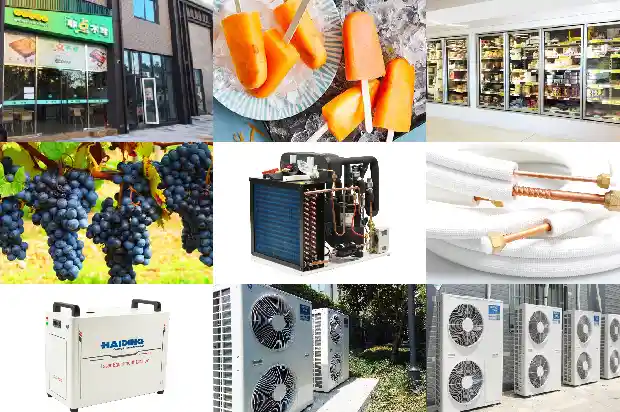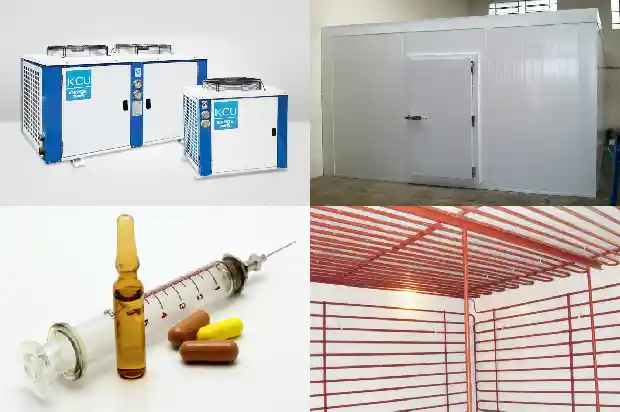Freezing Chamber System Blockage, Dirty Blockage, and Oil Blockage Characteristics and Treatment Methods
2024-08-29
- Characteristics and Treatment Methods of Ice Blockage in Cold Storage System
The characteristics of ice blockage in the cold storage system are that the compressor of the refrigeration system works normally, but the refrigeration effect is poor. The high-pressure exhaust pressure is lower than the normal value, and the low-pressure return gas pressure is also lower than the normal value or even negative. After ice blockage occurs in the refrigeration system, the refrigerant cannot circulate, causing the temperature in the cold storage to rise. Automatic defrosting occurs on the evaporator. After the evaporator is clean, the refrigeration system restores refrigeration.
Ice blockage in the thermal expansion valve generally occurs at the throttle orifice of the expansion valve. Its fault characteristics are: when the refrigeration system starts to operate, the refrigeration is normal. But after a period of time, the evaporator begins to show defrosting phenomenon. After the defrosting process is completed, the evaporator restores the refrigeration state. After a period of time, the defrosting phenomenon appears again.
The treatment method for the problem of ice blockage in the thermal expansion valve is: for slight ice blockage of the thermal expansion valve, a hot towel can be applied to the ice blockage of the thermal expansion valve to melt the ice blockage and restore the operation of the refrigeration system. If the degree of ice blockage is relatively serious and the normal operation of the refrigeration system cannot be restored, the stop valves at both ends of the drying filter can be closed.
Remove the drying filter from the refrigeration system. After replacing the desiccant in the drying filter, first open the stop valve at the inlet of the drying filter. Loosen the inlet union of the stop valve at the outlet of the drying filter. After gas runs out, tighten it and then open the stop valve at the outlet of the drying filter. Then the fault phenomenon can be eliminated and the normal operation of the refrigeration system can be restored.
- Characteristics and Treatment Methods of Dirty Blockage in Cold Storage System
The characteristics of dirty blockage in the cold storage system are that the compressor of the refrigeration system operates normally, but the evaporator does not frost. The high-pressure exhaust pressure is lower than the normal value, and the low-pressure return gas pressure is also lower than the normal value or even negative. After dirty blockage occurs in the refrigeration system, the refrigerant cannot circulate, causing the low-pressure protection action of the high and low pressure relay and the compressor stops. Manual startup again, and the fault phenomenon remains. This is a typical dirty blockage fault.
Dirty blockage often occurs in the thermal expansion valve. Its characteristics are: when there is frost on the inlet of the expansion valve (or frost on the valve cover), the temperature of the inlet pipe is lower than normal temperature, and even condensation occurs. The suction pressure of the compressor is lower than the corresponding normal pressure under the warehouse temperature. The temperature in the cold storage drops slowly or does not drop. This indicates that there is a dirty blockage phenomenon in the thermal expansion valve.
The treatment method for the problem of dirty blockage in the thermal expansion valve is: close the stop valve from the liquid outlet valve of the refrigeration system to the evaporator. Disassemble the inlet of the expansion valve, take out the filter screen, clean it with kerosene and reinstall it. After replacing the desiccant in the drying filter, first open the stop valve at the inlet of the drying filter. Loosen the inlet union of the stop valve at the outlet of the thermal expansion valve. After gas runs out, tighten it and then open the stop valve at the outlet of the thermal expansion valve. Then the fault phenomenon can be eliminated and the normal operation of the refrigeration system can be restored. - Characteristics and Treatment Methods of Oil Blockage in Cold Storage System
Oil blockage in the cold storage refrigeration system refers to the phenomenon that the valve orifice of the thermal expansion valve is blocked by solidified lubricating oil and hinders the flow of refrigerant.
It generally occurs in the refrigeration system of low-temperature cold storage or is caused by the selection of a freezing point that is too high and inferior refrigeration oil. Because the freezing point of inferior refrigeration oil is relatively high, it may cause the refrigeration oil to precipitate from the refrigerant and freeze into a thick paste-like state when flowing through the valve orifice of the thermal expansion valve due to a sudden drop in temperature, resulting in the blockage of the valve orifice of the thermal expansion valve. When encountering the problem of oil blockage in the refrigeration system, it is usually necessary to replace the refrigeration oil.
Related Articles
- Why Can Air - Source Heat Pumps Be Damaged by Freezing? How to Prevent Freezing in Winter?
- Refrigeration System Circulation and Components for Freezing and Cold Storage
- How to Prevent Freezing for Air Conditioning Refrigeration Equipment?
- Maintenance and Operation of Freezing and Cold Storage Warehouses
- Introduction to Key Points of Compressor Grouping in Quick-freezing Cold Storage
- How to distinguish the quality of refrigeration compressor unit of constant temperature and humidity test chamber?
- What Misconceptions Should Be Avoided in Low - temperature Refrigeration System Repairs
- Essential for Maintenance! Parameters and Phenomena of Normal Operation of Refrigeration and Heating Systems
- Introduction to Control Valves in Refrigeration Systems
- Welding Equipment Used in Refrigeration System Maintenance
- Where Lie the Key Construction Technologies of the Ammonia Refrigeration System?
- What Are the Differences Between R22 and R404A Cold Storage Systems?
- Selection of Bypass Control Valves for Air - conditioning Water Systems
- Has Your Refrigeration System Experienced "Oil Carry - over"?
- Basic Knowledge of Valve - type Components in Refrigeration Systems (Technical Sharing)
- Maintenance Techniques for Air - conditioning Refrigeration Systems
- Characteristics and Differences among Water System, Air System and Refrigerant System
- How to Select and Use Water Pumps for Air - conditioning Systems?
